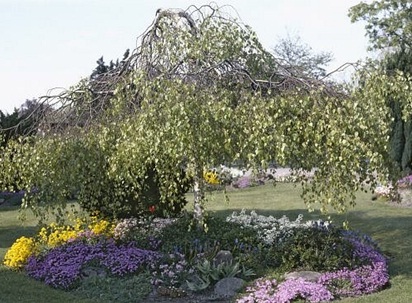Categories
Calendars
Guides
Reviews
Archive
Gallery
Articles
Ask Our Gardening Expert
Birch
They are ideal for garden situations because their open foliage causes little shade in summer. In winter, without their leaves, they have a distinctive form, with purplish grey branches and attractive, silvery, peeling bark. The leaves are usually toothed and a fresh, green colour and large catkins appear in spring. The catkins disintegrate, falling apart to release their seeds. The species grown for winter effect include the paper or canoe birch, Betula papyrifera, which has white, peeling bark and the silver birch, Betula pendula, which has white bark, roughening and blackening with age. ‘Youngii’ is a weeping form. A species with orange-red peeling bark is Betula albo-sinensis septentrionalis.
Betula pendula
In the natural state, birches form stands on well drained soils. They are a pioneer species, their seeds are easily wind borne and can quickly colonise open ground. They act as a ‘nurse tree’, sheltering longer lived trees until they reach maturity.
Betula ‘Youngii’
Birches are usually propagated from seed although some grafting is used. They are generally very hardy, can be planted in partial shade and no pruning is required. If they are topped or branches removed in the winter, they have a disconcerting habit of oozing large amounts of sap. They do recover and continue to grow. As birches are fast growing, they can be used to great effect in newly planted gardens and can be removed when slower growing trees establish themselves.
The birch, (Betula species) are graceful, deciduous trees, mostly of temperate climates, generally growing to 7-10m in height. 
